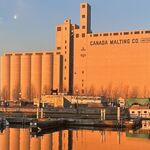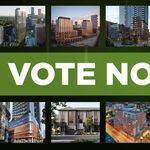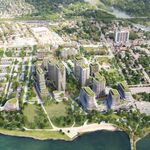unimaginative2
Senior Member
Here comes the neighbourhood!
How do you spot an area on the way up? Victor Dwyer looks at the signs of a community on the tipping point St. Clair West at Bathurst
VICTOR DWYER
October 27, 2007
At the northwest corner of Bathurst Street and St. Clair Avenue, construction is in the early stages of a high-rise condominium building calling itself The Forest Hill. "Rise to the Location" says the snazzy sign out front. Which, with 80 per cent of units presold, it seems a fair number of people are planning to do - even if Forest Hill itself (which doesn't begin until you cross Bathurst and head a few blocks north and east) isn't where the future building will stand.
But in Toronto, which never tires of billing itself as a city of neighbourhoods, rising to the location is what it's all about, as people scramble to predict which little ward will be the next to solidify into a Riverdale, a Bayview Village or an Annex.
The parcel of Toronto that straddles St. Clair Avenue as it stretches a dozen blocks west from Bathurst (known as Humewood to the north and Hillsdale to the south) provides a near-textbook case of a district that hopes to break the surly bonds of "not quite sure" and join the ranks of "we've arrived."
St. Clair is what Brits call the "high street": the central strip of retail, restaurants and services that attract (or dissuade) prospective buyers. So a walk along the thoroughfare delivers a handy checklist of the things that bode both well and ill for any neighbourhood.
STARBUCKS
It's a truism that among the most desirable of such amenities is a Starbucks - and this neighbourhood has had one for three years. Because the chain has the resources to conduct detailed analyses of an area's retail track record, Starbucks usually sets up shop in areas where it knows it will find the upscale, latte-loving kinds of clients it covets. Its arrival both stamps a neighbourhood with a degree of success and tends to propel it to future successes by that very stamp.
SHOPPERS DRUG MART
Canada has a chain of its own that stamps a retail strip with yuppie legitimacy - and this section of St. Clair is home to one. "Shoppers Drug Mart is a big plus for a neighbourhood and for housing values," says Prof. Murtaza Haider, director of the Institute of Housing and Mobility at Ryerson. Any store that appeals to Clinique-conscious women is good news for a neighbourhood hoping to draw upwardly mobile singles and families.
YOGA, BIKES AND PETS
It's a good sign that this strip has five stores catering to the needs of children. Other positive beacons: a bike shop (which probably signals, says Prof. Haider, a local clientele that's both environmentally aware and cares about fitness); a yoga studio (ditto on the fitness); an animal hospital (people who take good care of their pets); and a pair of great little bakeries: Patisserie Pain Perdu and Patachou.
UPSCALE NIGHTLIFE
Restaurants and nightspots are a decidedly mixed bag. Along with franchises such as the downscale 2-4-1 Pizza, KFC and McDonald's, there are a handful of fashionable establishments, like the ubercool Rushton. Still, the general resto vibe is nothing approaching College Street or Greektown.
"We could definitely use some more restaurants," says Hamid Razzak, who runs the lovely Atlas One Café. "The more there are, the more this area will thrive."
But, according to Prof. Haider, "households love to see restaurants nearby, but they seldom use those ones." Most people prefer to dine in areas that are already restaurant-heavy.
$100,000 INCOME
Demographics also play a part. Because Statistics Canada divides Toronto into fairly large areas when it compiles city-district profiles, it's impossible to pin down precise figures, but it's worth noting that in the Statscan district that runs north to Eglinton Avenue from this strip of St. Clair, 20 per cent of households have incomes of $100,000 or more - while 18 per cent have incomes of $20,000 or less. In the district running south from St. Clair more or less to Dupont Street, the breakdown is roughly the same.
SALVATION ARMY
Some Torontonians jokingly make the case that a local Goodwill or Salvation Army outlet is a reliable bellwether. Three of Toronto's trendiest strips of sidewalk - Queen Street just west of Spadina, College Street near Euclid, and Richmond at Augusta, now home to several upscale condos - at one time sported a Goodwill or Sally Ann.
Both exist in our textbook example: There's a Goodwill outlet that's several storefronts wide and an equally enormous Salvation Army store. They both give further testament to a sizable low-income population.
"You find those kinds of facilities in neighbourhoods where the people who use them actually live," notes David Amborski, director of the School of Urban and Regional Planning at Ryerson University, "because those people don't typically travel by car - they walk." Conversely, "If those stores begin to close down, you know you're really seeing a neighbourhood in transition."
LOCAL PORN SHOP
A more unapologetic case for proactive NIMBYism could easily be made for the neighbourhood's porn store. Although Prof. Haider concedes that lots of people these days wouldn't find such a shop especially offensive, "it still has a negative impact for house prices, because people with children don't want to walk by and have them ask, 'What's in there?' "
SHELTERS
Rev. Jeffrey Brown, who ministers at St. Michael and All Angels Anglican Church at St. Clair and Wychwood, is able to rhyme off a range of shelters and group homes in the streets around his church, thanks, in part, to the area's capacious housing stock. Rev. Brown notes that "even semis in the neighbourhood are going for half a million dollars, and there are a few big, million-dollar homes." But it's a fact of urban life that shelters and group homes require large premises - and, over the years, have found them around this part of St. Clair.
DOLLARAMA
Interspersed with unabashed yuppie toeholds - chic florists Fiori and Foglie, and the sweet Zia Mosaics - are a fair number of "marginal stores": a sad junk shop purporting to sell antiques; the downscale Dollarama; a "discount designers originals" store whose sidewalk bins consistently spill over with $5 bras; and a far-from-chic beauty parlour whose services include "full-face threading."
"That's what makes us unique," says Mr. Razzak, the restaurateur. "Not everyone is 100-per-cent rich. You don't want a Yorkville here, with just one kind of people."
REFLECTED GLORY
It's worth noting that the condo-monicker-inspiring, fashionable Forest Hill is only a stone's throw away.
Just having it next door, says real-estate agent JoAnn Armstrong, who has sold several houses in these parts over the past 20 years, has always given this humbler 'hood a more confident swagger.
Let's face it, when it comes to the upward mobility of Toronto neighbourhoods, a dash of ballsy swagger - anyone been to the allegedly cutting-edge, but darn seedy-to-the-naked-eye Junction lately? - is at least as important as a Starbucks.
*****
Location, location, location
Living in a good neighbourhood is one thing. But you also want to be in the right part of that neighbourhood. Here are three important amenities it's wise to live near - but not too near.
The main drag: Even in the best neighbourhood, one thing you almost certainly don't want is to be within the first few houses of the high street itself. "You want to be near the services on hand, but you don't want front-seat views of late-night brawls, or broken bottles in your backyard," Prof. Haider says.
Public transit: "All else being equal, identical homes nearer to public transit will sell for significantly more as time goes on," says Prof. Haider. But some "better ways" are better than others.
St. Clair and Bathurst residents live near the very best TTC options: an actual subway station (St. Clair West) and a streetcar line (running on a hotly contested right-of-way) on St. Clair Avenue. Both embody what every homeowner should aim to have nearby, and what mere buses and streetcars don't provide: transit that's virtually traffic-jam-proof.
One coda: "In terms of noise and congestion, being really close to the streetcar street can be too close for comfort," Prof. Haider says.
Schools: You want to be within comfortable walking distance of a good school (whether for your own kids or those of future buyers), ideally without the need to cross major streets. But, as with those streetcar tracks, you want to be far enough away to avoid "externalities" - in this case, noise, foot traffic and litter. This applies especially to high schools, whose principals will attest that a significant part of their job involves dealing with irate neighbours. Rebelliousness, boredom, hormones and peer pressure can spell property damage, trampled gardens and even break-ins.
Victor Dwyer
How do you spot an area on the way up? Victor Dwyer looks at the signs of a community on the tipping point St. Clair West at Bathurst
VICTOR DWYER
October 27, 2007
At the northwest corner of Bathurst Street and St. Clair Avenue, construction is in the early stages of a high-rise condominium building calling itself The Forest Hill. "Rise to the Location" says the snazzy sign out front. Which, with 80 per cent of units presold, it seems a fair number of people are planning to do - even if Forest Hill itself (which doesn't begin until you cross Bathurst and head a few blocks north and east) isn't where the future building will stand.
But in Toronto, which never tires of billing itself as a city of neighbourhoods, rising to the location is what it's all about, as people scramble to predict which little ward will be the next to solidify into a Riverdale, a Bayview Village or an Annex.
The parcel of Toronto that straddles St. Clair Avenue as it stretches a dozen blocks west from Bathurst (known as Humewood to the north and Hillsdale to the south) provides a near-textbook case of a district that hopes to break the surly bonds of "not quite sure" and join the ranks of "we've arrived."
St. Clair is what Brits call the "high street": the central strip of retail, restaurants and services that attract (or dissuade) prospective buyers. So a walk along the thoroughfare delivers a handy checklist of the things that bode both well and ill for any neighbourhood.
STARBUCKS
It's a truism that among the most desirable of such amenities is a Starbucks - and this neighbourhood has had one for three years. Because the chain has the resources to conduct detailed analyses of an area's retail track record, Starbucks usually sets up shop in areas where it knows it will find the upscale, latte-loving kinds of clients it covets. Its arrival both stamps a neighbourhood with a degree of success and tends to propel it to future successes by that very stamp.
SHOPPERS DRUG MART
Canada has a chain of its own that stamps a retail strip with yuppie legitimacy - and this section of St. Clair is home to one. "Shoppers Drug Mart is a big plus for a neighbourhood and for housing values," says Prof. Murtaza Haider, director of the Institute of Housing and Mobility at Ryerson. Any store that appeals to Clinique-conscious women is good news for a neighbourhood hoping to draw upwardly mobile singles and families.
YOGA, BIKES AND PETS
It's a good sign that this strip has five stores catering to the needs of children. Other positive beacons: a bike shop (which probably signals, says Prof. Haider, a local clientele that's both environmentally aware and cares about fitness); a yoga studio (ditto on the fitness); an animal hospital (people who take good care of their pets); and a pair of great little bakeries: Patisserie Pain Perdu and Patachou.
UPSCALE NIGHTLIFE
Restaurants and nightspots are a decidedly mixed bag. Along with franchises such as the downscale 2-4-1 Pizza, KFC and McDonald's, there are a handful of fashionable establishments, like the ubercool Rushton. Still, the general resto vibe is nothing approaching College Street or Greektown.
"We could definitely use some more restaurants," says Hamid Razzak, who runs the lovely Atlas One Café. "The more there are, the more this area will thrive."
But, according to Prof. Haider, "households love to see restaurants nearby, but they seldom use those ones." Most people prefer to dine in areas that are already restaurant-heavy.
$100,000 INCOME
Demographics also play a part. Because Statistics Canada divides Toronto into fairly large areas when it compiles city-district profiles, it's impossible to pin down precise figures, but it's worth noting that in the Statscan district that runs north to Eglinton Avenue from this strip of St. Clair, 20 per cent of households have incomes of $100,000 or more - while 18 per cent have incomes of $20,000 or less. In the district running south from St. Clair more or less to Dupont Street, the breakdown is roughly the same.
SALVATION ARMY
Some Torontonians jokingly make the case that a local Goodwill or Salvation Army outlet is a reliable bellwether. Three of Toronto's trendiest strips of sidewalk - Queen Street just west of Spadina, College Street near Euclid, and Richmond at Augusta, now home to several upscale condos - at one time sported a Goodwill or Sally Ann.
Both exist in our textbook example: There's a Goodwill outlet that's several storefronts wide and an equally enormous Salvation Army store. They both give further testament to a sizable low-income population.
"You find those kinds of facilities in neighbourhoods where the people who use them actually live," notes David Amborski, director of the School of Urban and Regional Planning at Ryerson University, "because those people don't typically travel by car - they walk." Conversely, "If those stores begin to close down, you know you're really seeing a neighbourhood in transition."
LOCAL PORN SHOP
A more unapologetic case for proactive NIMBYism could easily be made for the neighbourhood's porn store. Although Prof. Haider concedes that lots of people these days wouldn't find such a shop especially offensive, "it still has a negative impact for house prices, because people with children don't want to walk by and have them ask, 'What's in there?' "
SHELTERS
Rev. Jeffrey Brown, who ministers at St. Michael and All Angels Anglican Church at St. Clair and Wychwood, is able to rhyme off a range of shelters and group homes in the streets around his church, thanks, in part, to the area's capacious housing stock. Rev. Brown notes that "even semis in the neighbourhood are going for half a million dollars, and there are a few big, million-dollar homes." But it's a fact of urban life that shelters and group homes require large premises - and, over the years, have found them around this part of St. Clair.
DOLLARAMA
Interspersed with unabashed yuppie toeholds - chic florists Fiori and Foglie, and the sweet Zia Mosaics - are a fair number of "marginal stores": a sad junk shop purporting to sell antiques; the downscale Dollarama; a "discount designers originals" store whose sidewalk bins consistently spill over with $5 bras; and a far-from-chic beauty parlour whose services include "full-face threading."
"That's what makes us unique," says Mr. Razzak, the restaurateur. "Not everyone is 100-per-cent rich. You don't want a Yorkville here, with just one kind of people."
REFLECTED GLORY
It's worth noting that the condo-monicker-inspiring, fashionable Forest Hill is only a stone's throw away.
Just having it next door, says real-estate agent JoAnn Armstrong, who has sold several houses in these parts over the past 20 years, has always given this humbler 'hood a more confident swagger.
Let's face it, when it comes to the upward mobility of Toronto neighbourhoods, a dash of ballsy swagger - anyone been to the allegedly cutting-edge, but darn seedy-to-the-naked-eye Junction lately? - is at least as important as a Starbucks.
*****
Location, location, location
Living in a good neighbourhood is one thing. But you also want to be in the right part of that neighbourhood. Here are three important amenities it's wise to live near - but not too near.
The main drag: Even in the best neighbourhood, one thing you almost certainly don't want is to be within the first few houses of the high street itself. "You want to be near the services on hand, but you don't want front-seat views of late-night brawls, or broken bottles in your backyard," Prof. Haider says.
Public transit: "All else being equal, identical homes nearer to public transit will sell for significantly more as time goes on," says Prof. Haider. But some "better ways" are better than others.
St. Clair and Bathurst residents live near the very best TTC options: an actual subway station (St. Clair West) and a streetcar line (running on a hotly contested right-of-way) on St. Clair Avenue. Both embody what every homeowner should aim to have nearby, and what mere buses and streetcars don't provide: transit that's virtually traffic-jam-proof.
One coda: "In terms of noise and congestion, being really close to the streetcar street can be too close for comfort," Prof. Haider says.
Schools: You want to be within comfortable walking distance of a good school (whether for your own kids or those of future buyers), ideally without the need to cross major streets. But, as with those streetcar tracks, you want to be far enough away to avoid "externalities" - in this case, noise, foot traffic and litter. This applies especially to high schools, whose principals will attest that a significant part of their job involves dealing with irate neighbours. Rebelliousness, boredom, hormones and peer pressure can spell property damage, trampled gardens and even break-ins.
Victor Dwyer




